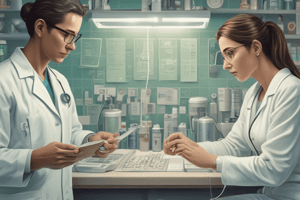Podcast
Questions and Answers
Match the type of biological specimen with its description:
Match the type of biological specimen with its description:
Sputum = Expectorated mucus from the respiratory tract Urine = Liquid waste produced by the kidneys Blood = Fluid that circulates in the cardiovascular system Tissue = Collection of cells from any part of the body
Match the specimen collection method with the appropriate type:
Match the specimen collection method with the appropriate type:
Sputum induction = Nebulized hypertonic saline solution to assist in coughing Midstream urine = Clean technique to reduce contamination Bronchial lavage = Washing out the bronchial tubes for sampling Throat swab = Swabbing the back of the throat for pathogens
Match the specimen preparation instruction with the type:
Match the specimen preparation instruction with the type:
Sputum = Patient must expectorate into a sterile container Urine = Collect midstream to avoid contamination Blood = Drawn from a vein for analysis Pus = Obtained from an abscess or infected area
Match the specimen type with the associated culture:
Match the specimen type with the associated culture:
Signup and view all the answers
Match the specimen type with its common use in microbiological studies:
Match the specimen type with its common use in microbiological studies:
Signup and view all the answers
Match the precaution with its purpose in specimen collection:
Match the precaution with its purpose in specimen collection:
Signup and view all the answers
Match the prompt with its associated specimen collection scenario:
Match the prompt with its associated specimen collection scenario:
Signup and view all the answers
Match the specimen type with the collection requirement:
Match the specimen type with the collection requirement:
Signup and view all the answers
Study Notes
Specimen Collection for Microbiological Studies
- Types of biological specimens include sputum, urine, feces, blood, bone marrow, pus, wound, tissue, body fluids, bronchial/wash/lavage, throat swab, ear, and eye.
Identifying Sputum
- Sputum is thick and sticky, unlike saliva, which is thin and watery.
Sputum Collection Procedure
- Clear the mouth.
- Breathe in and out three times.
- Provide a sputum sample.
Sputum Collection Instructions
- Rinse the mouth with clean water to remove food particles.
- Have the patient breathe deeply and cough to achieve a deep specimen.
- Collect the specimen in a dry, sterile container.
- Transport the specimen immediately at ambient temperature.
- Refrigerate if a delay of more than one hour is anticipated.
Sputum Testing
- Expectorated sputum is suitable for bacterial, mycobacterial, and fungal cultures.
- Microbiology Labs may reject samples that are not indicative of deeply expectorated specimens.
TB Sputum Collection
- Patients with clinical and chest x-ray findings consistent with TB should collect three early morning sputum specimens (preferably on three separate days)
- Collect specimens in sterile containers with tightly sealed lids.
- Transport to the lab in double sealed bags.
Induced Sputum Collection
- Sputum induction helps patients cough up secretions.
- The procedure creates extra moisture in the airways to loosen and thin the secretions, making coughing easier.
- The patient inhales nebulized hypertonic saline solution This liquefies airway secretions, promotes coughing, and allows expectoration of respiratory secretions.
- Sputum induction is a simple and non-invasive procedure..
- Infectious droplets, if present, may be expelled into the room air during the procedure, so airborne respiratory precautions must be taken.
Sputum Tests
- Sputum testing typically involves Gram stain, culture, macroscopic analysis, microscopic examination, and acid-fast stain.
Urine Collection for Cultures
- Wash hands thoroughly, then wash the urinary opening and surrounding area.
- Take a sterile cup in the other hand, without touching the rim or inner surface.
- Void 20-25 ml into the toilet, then collect the remaining urine into the cup.
- Securely close and immediately transport the cup to the lab.
- Refrigerate the urine in case of a delay
Indwelling Catheter Urine Collection
- Do not collect urine from the drainage bag, as bacteria may grow outside the catheter.
- Clean the catheter with an alcohol pad.
- Use a sterile needle and syringe to puncture the tubing and aspirate urine directly.
- Transfer the urine to a sterile specimen container.
- Immediately transport to the lab and refrigerate in case of delay
Urine for AFB Culture
- Collect the entire first morning urine specimen, ideally on three consecutive days.
- Collect the specimen in a sterile container provided by the lab.
Stool/Feces Collection
- Collect specimens in a clean bed pan or plastic wrap placed between the toilet seat and bowl.
- Do not submit stool specimens contaminated with urine or toilet water.
- Transfer the specimen to a clean, dry container, or an appropriate preservative.
- Transport specimens at ambient temperature within two hours of collection.
Studying That Suits You
Use AI to generate personalized quizzes and flashcards to suit your learning preferences.
Related Documents
Description
This quiz covers the procedures and guidelines for collecting sputum specimens for microbiological studies. It includes details on types of specimens, the sputum collection procedure, and testing methods. Understanding these procedures is crucial for accurate diagnosis and treatment.




